2
IMPORTANT SAFETY INSTRUCTIONS
1. Power source—Connect the unit to a power source of the type
described in these instructions or as marked on the unit.
2. Polarization—The unit is equipped with a polarized power plug where
one blade is wider than the other. This safety feature ensures that the
plug fits into your household AC outlet only one way. If the plug
doesn’t fit one way, try reversing it. If the plug still doesn’t fit, contact
an electrician to replace the obsolete outlet. Do not attempt to defeat
the safety purpose of the plug.
3. Power cord protection—Route the AC power supply cord so that it
will not be walked on or pinched by items placed on or against it.
Never take hold of the plug or cord with wet hands. Always grasp the
plug body firmly when connecting and disconnecting it.
4. Overloading—When connecting the AC power supply cord, be careful
not to overload the household AC outlet, extension cord, or outlet
from any other device as this can result in fire or electric shock.
5. Nonuse periods—Turn the unit off when it is not in use. Unplug the
unit from the household AC outlet if it is not to be used for a long
time. Unplug the unit during lightning storms. Leaving the unit
connected to a household AC outlet for extended periods can cause
battery fluid leakage.
6. Attachments and accessories—Use only the attachments and
accessories recommended in these operating instructions.
∫Placement
1. Foreign material—Ensure objects and liquids do not get into the unit.
Avoid exposing the unit to excessive smoke, dust, mechanical
vibration, and shock.
2. Magnetism—Situate the unit away from equipment and devices that
generate strong magnetic fields.
3. Stacking—Do not place anything on top of this unit.
4. Wall and ceiling mounting—Do not mount the unit on walls or
ceilings unless specified in the instructions.
∫Environment
1. Water and moisture—Do not use the unit near water, such as near a
bathtub or swimming pool. Avoid damp basements.
2. Heat—Situate the unit away from heat sources, such as radiators. Do
not leave it in an automobile exposed to direct sunlight with the doors
and windows closed as this may deform the cabinet.
2. Do not situate where temperatures fall below 5 oC (41 oF) or rise above
35 oC (95 oF).
Safety
Unplug the unit from the household AC outlet before cleaning.
Clean with a damp cloth.
Do not use abrasive pads, scouring powders, or solvents.
1. Damage requiring service—The unit should be serviced by qualified
service personnel if:
1. (a) The AC power supply cord or AC adaptor has been damaged; or
1. (b) Objects or liquids have gotten into the unit; or
1. (c) The unit has been exposed to rain; or
1. (d) The unit does not operate normally or exhibits a marked change
in performance; or
1. (e) The unit has been dropped or the cabinet damaged.
2. Servicing—Do not attempt to service the unit beyond that described
in these operating instructions. Refer all other servicing to authorized
servicing personnel.
3. Replacement parts—When parts need replacing ensure the servicer
uses parts specified by the manufacturer or parts that have the same
characteristics as the original parts. Unauthorized substitutes may
result in fire, electric shock, or other hazards.
4. Safety check—After repairs or service, ask the servicer to perform
safety checks to confirm that the unit is in proper working condition.
Installation
Maintenance
Service
Read these operating instructions carefully before using the unit. Follow the safety instructions on the unit and the safety precautions listed below. Keep
these operating instructions handy for future reference.
∫Batteries
≥Do not peel off the covering on batteries and do not use if the covering
has been peeled off.
≥Align the poles + and - correctly when inserting the batteries.
≥Do not mix different types of batteries or old and new batteries.
≥Remove the batteries if you do not intend to use the unit for a long time.
≥Do not throw into fire, short-circuit, disassemble, or subject to excessive
heat.
≥Do not attempt to recharge dry cell batteries.
≥When carrying batteries in a pocket or bag, ensure no metal objects
such as necklaces are placed together with them. Contact with metal
may cause short-circuiting which can cause a fire. For safety, carry the
rechargeable batteries in the battery carrying case.
∫CDs
≥Do not use irregularly shaped CDs.
≥Do not use non-specification discs.
≥Do not use CDs printed with label printers available on the market.
≥Do not use CDs with labels and stickers that are coming off or with
adhesive exuding from under labels and stickers.
Caution
A nickel cadmium battery that is recyclable powers the
product you have purchased. At the end of its useful life, under
various state and local laws, it is illegal to dispose of this
battery into your municipal waste stream. Please call 1-800-8-
BATTERY for information on how to recycle this battery.
∫Listening
Do not play your headphones or earphones at a high volume. Hearing
experts advise against continuous extended play.
If you experience a ringing in your ears, reduce volume or discontinue
use.
Do not use while operating a motorized vehicle. It may create a traffic
hazard and is illegal in many areas.
You should use extreme caution or temporarily discontinue use in
potentially hazardous situations.
Even if your headphones or earphones are the open-air type designed to
let you hear outside sounds, don’t turn up the volume so high that you
can’t hear what’s around you.
Sound can be deceiving. Over time your hearing “comfort level” adapts to
higher volumes of sound. So what sounds “normal” can actually be loud
and harmful to your hearing.
Guard against this by setting your equipment at a safe level BEFORE your
hearing adapts.
To establish a safe level:
≥Start your volume control at a low setting.
≥Slowly increase the sound until you can hear it comfortably and clearly,
and without distortion.
Once you have established a comfortable sound level:
≥Leave it there.
∫Allergies
Discontinue use if you experience discomfort with the earphones or any
other parts that directly contact your skin. Continued use may cause
rashes or other allergic reactions.




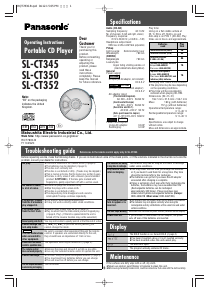
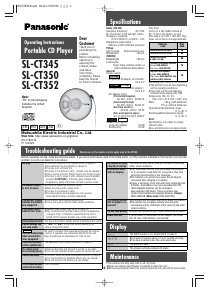

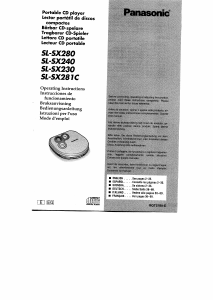
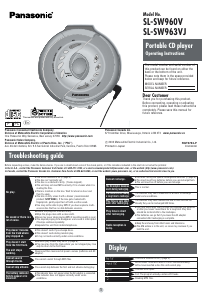
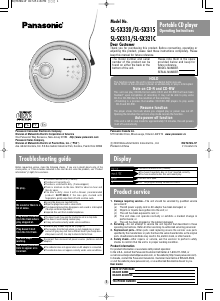
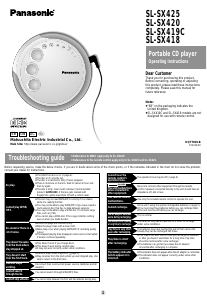
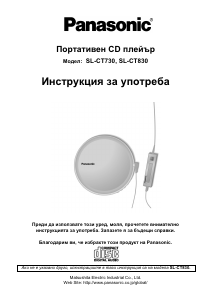
Join the conversation about this product
Here you can share what you think about the Panasonic SL-SX419CPC Discman. If you have a question, first carefully read the manual. Requesting a manual can be done by using our contact form.